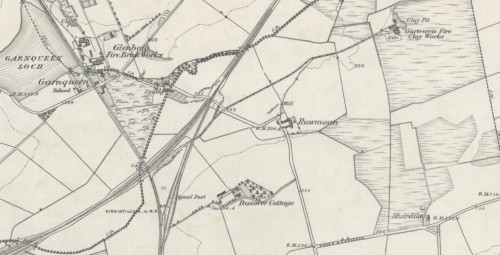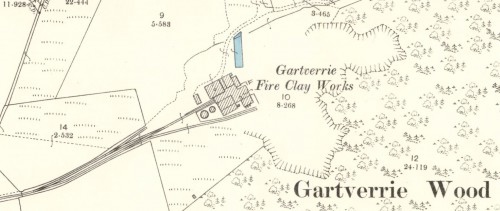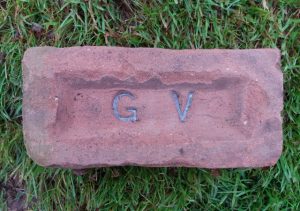Gartverrie Brickworks, Glenboig, Coatbridge, North Lanarkshire aka Gartverie.
Canmore
12/01/1855 – Glasgow Herald – Royal Patriotic Fund, Lanarkshire – John McDonald, Gartverrie Brickworks £1.
10/06/1856 – Inverness Courier – 19/06/1856 – Deaths – At Bridge of Allan on the 10th inst, Mr John MacDonald of Gartverie Fire Clay Works.
25/06/1856 – Glasgow Herald – Notice to creditors – Parties having a claim against or due to the Estate of the late Mr John MacDonald of Gartverie Fire Clay Works are requested to lodge the same within eight days with Mr A.G MacDonald, 20 St Vincent Place, Glasgow.
1858 – Mineral Statistics of the United Kingdom of Great Britain and Ireland for 1858. Gartverrie, clay of coal measures. Name of freeholder J. H. Colt. Manufacturer. Heirs of the late J McDonald. Manufacture. Bricks. Estimated 1,600 tons annually.
Below – 1858 – 59 – Gartverrie Fire Clay Works, Glenboig, Coatbridge.

1858 – 1861 – Ordnance Survey Name Books – Gartverrie Fireclay Works. Mr Lang Manager. A tolerably sized Fire Clay Work the property of A.G. McDonald, Glasgow.
1868 – A. McDonald and Co., brickmakers, Gartverrie Brickworks, Coatbridge:
1869 – Office, 62 Robertson Street, Glasgow.
1872 – W. Lang, brickmaker, Gartverrie Brickwork, Coatbridge.
1872 – William Lang, brick manufacturer, Castlepales, Airdrie. (Castlepales is located very close to Gartverrie).
1875 – Falkirk Museum has a quotation from the company offering silicate bricks at 57s 6d and firebricks at 42 s 6d per 1000, and ground fireclay at 5s 6d per ton. Silicate fireclay/Ganister was quoted at 8s per ton.
1879 – 1880 – Murdoch, Alex., agent for Abernant Dinas fire-bricks, Stourbridge glasshouse pot and crucible clays, Gartverrie Roman fire-bricks, 2 Oswald Street; Ho. 248 Scotland Street
07/05/1880 – Dundee Courier – Accident on the railway. A labourer named William Johnstone was severely injured at Gartverrie Fire Clay Works, Glenboig where he was employed. He had been engaged in shunting wagons when he stumbled and fell before the wheels, which passed over his right leg between the ankle and the knee, crushing it terribly. Johnstone was attended by Dr Wilson, Coatbridge who ordered him to be removed to Glasgow Royal Infirmary.
1881 – Invoice – Gartverrie Fire Clay Co, Gartverrie Fire Clay Works by Coatbridge. Office 62 Robertson Street, Glasgow. Makers of silicate fire and composition bricks, covers, furnace blocks &c. Pig-bed, furnace and ground glass sand.
1882 – Gartverrie Fire Clay Co, Gartverrie. Office 62 Robertson Street, Glasgow.
04/07/1885 – Airdrie and Coatbridge Advertiser – A milkman named William McGowan (21), residing at Wellhouse, New Monkland, was shunting some waggons at Gartverrie Brickworks, near Coatbridge, on Wednesday, when he accidentally fell off a waggon and had both his legs run over by the wheels, besides sustaining severe injury about the shoulder. He was taken to the Royal. Infirmary, where one of his legs was amputated. He lies in a critical state.
31/08/1885 – Glasgow Herald – Mining exhibition and refers to The Gartverrie Fireclay Company being present.
20/11/1885 – Rutherglen Reformer – Seven labouring were on Monday brought before Justices at Airdrie charged with lodging sleeping in a brick store at Gartverrie Brickwork without consent of proprietors in contravention of the Trespass Act. The men each tendered a plea of guilty and stated that they had been out of work for some time and being very cold on Saturday night and having no place of abode they took refuge in the brick store where there was a large stove for drying bricks and which also ministered to their comfort They were each fined 5s or three days. It may be stated that a large number of cases of this kind are disposed of every week in the JP Court and is a sufficient indication of the scarcity of work wages.
31/05/1886 – Glasgow Herald – The International Exhibition refers to the Gartverrie Fireclay Works as exhibiting.
24/01/1889 – Glasgow Herald – Yesterday it was reported that a labourer named John Gibson had his right hand severely injured by being accidentally caught in the machinery of the sand mill in Gartverrie Brickworks, Glenboig. The flesh was torn off from the wrist to the finger and the arteries were cut. The man was removed to the Royal Infirmary, Glasgow.
1893 – 1894 – George A. Bishop, Gartverrie Fireclay Works, Glenboig, Coatbridge. N.B.
1894 – Robert Lang, brick manufacturer, Castlepales (Castlepails), Airdrie. (Gartverrie Fire Clay Works?).
02/02/1895 – Invoice – Gartverrie Fire Clay Co, Gartverrie Fire Clay Works, Glenboig. Makers of silicate and fire clay bricks, covers, furnace blocks &c. Silica sand and ground glass sand, mill furnace and pig bed sand.
Below – 1896 – Gartverrie Fire Clay Works, Glenboig, Coatbridge.

1896 – 1897 – Gartverrie Fire Clay Co, Glenboig.
21/10/1897 – Glasgow Herald – The 15th annual meeting of the Glenboig Union Fireclay Company Limited … During the past year the company had acquired adjacent property and the works of Gartverrie and two subways were being constructed, one of which was intended to connect those works with Glenboig … Mr James Dunnachie elected as managing director …
1901 – Directory of Clayworker – G. A. Bishop, Gartverrie Fireclay Works, Glenboig N.B. (Note – SBH – As the Glenboig Union Fireclay Company appear to have purchased the Gartverrie Fireclay Works in 1897 – see 21/10/1897 – then, G. A. Bishop may have been the manager of the Gartverrie Works).
1901 – Directory of clay workers – Gartverrie Fire Clay Company, Gartverrie Works, Glenboig N.B. Silver, silica and mill furnace sand and ground fire clay. T. add Gartverrie Glenboig.
29/04/1911 – Airdrie and Coatbridge Advertiser – Glenboig Fireclay as a mineral. In the House of Lords on Thursday the Lord Chancellor and Lords Macnaghten, Shaw and Robson commenced the hearing of an appeal by the Caledonian Railway Company, the respondents being the Glenboig Union Fireclay Company (Limited). The appellants sought to interdict the respondents from working beds or seams of fireclay or clay in the land, of Gartverrie and Ramoan underneath or adjacent to the Castlecary and Garnkirk branches of the appellant’s railway near to Glenboig Station. The question for decision is whether the beds and seams of fireclay of which the respondents are tenants are so far as situated in the lands acquired by the appellants to be deemed to be excepted out of the conveyances in favour of the appellants as falling within the exception of mines of coal, ironstone, slate, or other minerals under the lands purchased by the appellants within the meaning of Section 70 of the Railway Clauses Act, 1845. In short, the question is whether fireclay is a mineral within the meaning of that section. The appellants submit that the fireclay in question is not a mineral within the meaning of the Railway Clauses Act, in respect of that it is a common rock of the district and forms the substratum of the soil with, no doubt, other kinds of rock intermixed. They further submit that the fireclay is part of the subjects purchased by them when they acquired the lands. The respondents, on the other hand, maintain that the fireclay is a mineral within the meaning of the Act of 1845 and that the fireclay in question is excepted from the conveyances in favour of the appellants. The Lord Ordinary refused the interdict and the First Division upheld this decision. Against these judgments of the Courts below the present appeal is taken to the House of Lords. Mr. Clyde had not finished his speech opening the case for the appellants when their Lordships adjourned. The Lords heard further proceedings in the case yesterday, and at its conclusion dismissed the appeal with costs.
25/01/1921 – The Scotsman – Reference to the Glenboig Union Fireclay Company Limited suing the Caledonian Railway. Also references that Glenboig Union Fireclay Company Limited was the lessee of the fireclay at Gartverrie from at least 1908.
21/04/1921 – The Scotsman – Refers to the sale of the Gartsherrie Estate including The Gartverrie Fireclay Works and Quarry.
25/09/1931 – Motherwell Times – Deaths – James Craik Bishop of Barncluith, Hamilton, Writer of Glasgow, a partner in the firm of Milne, Boyd and Co and in the Gartverrie Fire Clay Company, a director of the Cadzow Coal Company and of CoatsTrades Hotel Ltd, a secretary of the Scottish Ironmasters Association, of the Scottish Manufactured Iron Trade Employers Association and of the Scottish Steel Founders Wages Association left a personal estate in Great Britain of £24, 636.
c. 1939 – Brick manufacture ceased?
c. 1945 – The Company was bought by the Glenboig Union Company for £1,200 who used the sand for brick setting and supply to the local iron foundries. Some building bricks were made. (Note – SBH – These are possible in reference to the bricks marked GV).
c. 1950s – “A survey of Scottish brickmarks” – Brickworks closed.
(Note – SBH – References to Gartverrie Ltd below are a different company but may or may not have been located on the same site – for clarification).
24/06/1937 – Gartverrie Ltd incorporated.
1939 – 40 – Gartverrie Limited, quarry masters, brick manufacturers. 19 Waterloo Road, C2. Tel address Gartverrie Glasgow.
1961 – 1962 – A directory of British clay products and manufacturers – Gartverrie Ltd, 19 Waterloo Street, Glasgow. Tel Glasgow Central 6065. Coloured facing bricks.
06/09/1989 – Kenneth Macleod Stirling Company director.







